By Kelly Bell
The first torpedo struck the Shinano carrier farthest aft. Over the next 30 seconds three more warheads detonated against the massive aircraft carrier’s hull, working their way forward. The explosions and instant flooding immediately killed scores of men, many asleep in their bunks.
As tons of seawater cascaded into the wounded colossus, men below deck could see the extent of the damage, were seized with panic, and stampeded topside. The missiles had hit 10 feet below the water line, and on the bridge and upper levels the commander and his officers were not yet aware of how sorely they were hurt. Many had survived earlier torpedo attacks, and aboard less formidable vessels than this one. Even as their gargantuan ship began to list, they remained optimistic.
“Expressing the Flavor of an Ancient Samurai”
As 1944 neared its end, the tottering Japanese empire toiled terribly to find ways to hold off U.S. forces as they advanced ever closer to the Home Islands. U.S. troops under General Douglas MacArthur were resolutely reclaiming the Philippines. Huge Boeing B-29 Superfortress bombers were beginning the destruction of Japan’s major cities. Perhaps most devastating were the omnipresent U.S. Navy submarines that were sweeping Japanese shipping from the South Pacific. Yet, if the Imperial Navy could produce a single monster of a warship perhaps it could at least temporarily stem the advance of the enemy. Maybe this floating megaweapon could even check or turn back the Philippine liberation and abort the anticipated attack on Okinawa.
The Shinano carrier started out as the third sister of a planned trio of super battleships that included the 70,000-ton Musashi and the Yamato. After the crippling loss of aircraft carriers inflicted on the Japanese Navy at the Battle of Midway, Shinano’s construction was altered to instead make her into the largest carrier ever to float. Named for a province of medieval Japan, Shinano’s builders hoped to have her seaworthy in her redesigned state by February 1945, yet rapidly waning military fortunes resulted in a quickened pace of construction. Overworked shipyard workers toiled in 16-hour shifts to complete the great warship.
Captain Toshio Abe, a graduate of the Japanese naval academy, was assigned to command Shinano. A survivor of the crushing defeat at Midway, where he had commanded a destroyer, he was a humorless, undiplomatic, and highly competent career officer. His newly assigned medical officer, Lt. Cmdr. Takamasa Yasuma, later described him as “expressing the flavor of an ancient samurai. He seemed to be a man of strong will and apparently was respected by his officers and men.”
From the Desk to the Seas
Abe’s future adversary, Joseph Francis Enright, was a 1933 graduate of the U.S. Naval Academy at Annapolis. As a lieutenant he was given his first command, the submarine S-22, immediately after Midway. She was an old sub used for training young sailors in undersea warfare. In the spring of 1943, Enright was promoted to lieutenant commander and placed in command of the submarine USS Dace. Embarking on his first war patrol late that year, he was not pleased with his own performance. He stalked and lost a succession of ripe military and merchant targets. At one point, because of an overcautious approach during which he ignored his gut instinct to attack aggressively and instead made a time-consuming, by-the-book stalk, he botched an excellent opportunity to attack the aircraft carrier Shokaku. Enright returned to Midway on December 11 without having fired a shot.
On his own recommendation, Enright was relieved of his command. He was then promoted to full commander and assigned the desk job of executive officer of Midway’s submarine base. In a study of wartime irony, Enright’s career at sea was rescued by a poker game.
His spirits were lower than ever late in the summer of 1944. His mother had died suddenly back in the States, and he was stuck in an administrative position where he could make no significant contribution to the war effort. He wrote a letter to the Midway naval base’s commander, Admiral Charles Lockwood, requesting another submarine command, but received no response. Then Enright wound up in a late-night card game with one of Lockwood’s subordinate commanders, a Captain Pace, who was impressed with Enright’s fearless and aggressive style of poker playing. At the game’s conclusion Pace asked Enright, “Joe, would you run a submarine the way you play poker?”
“Yes, sir.”
“Okay Joe, I like your spirit. You can have the next available submarine.”
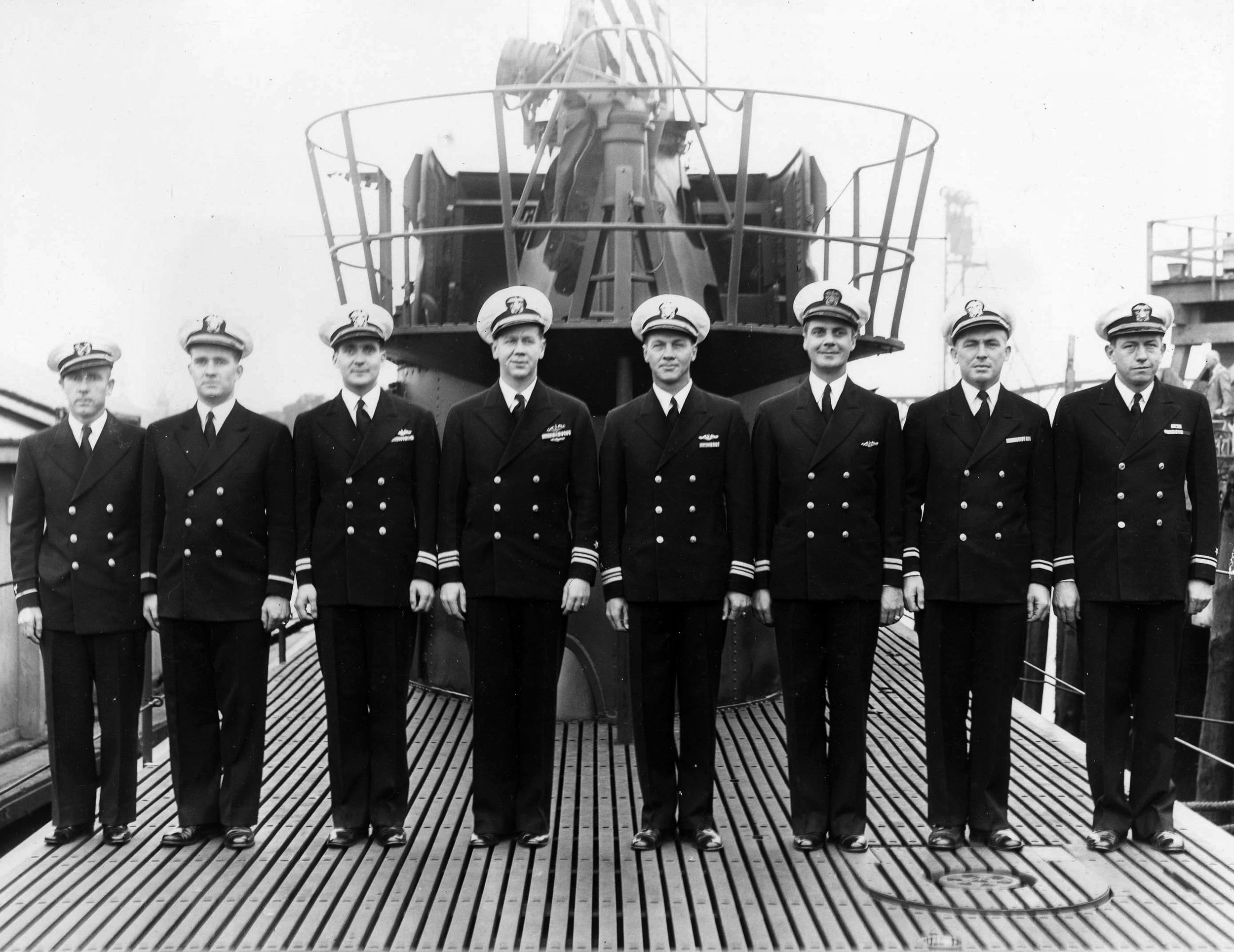
Shinano: Japan’s Secret Super-Carrier
On September 24, 1944, Enright was discharged from his desk and given command of the USS Archer-Fish, which was just returning from her fourth war patrol. He rode his new boat from Midway to Pearl Harbor, where she was intensively serviced, her stores replenished, and her crew rested and rotated. Under her new skipper she set forth on her fifth war cruise on October 30, 1944. She and her men had a whale of an adventure awaiting them.
Almost as crucial as Shinano’s weaponry was the secrecy under which she was built. If the Americans learned of her presence in dry dock no. 6 of Yokosuka Naval Shipyard on the west shore of Tokyo Bay, they would dispatch their B-29s to pound her into rubble before she could take to her native element. Besides, if she could be completed and sent into action without the Allies knowing, her sudden appearance off the Philippines would be a devastating shock for them.
Shinano was constructed within a massive, roofed concrete fence. Her dry dock was off limits to anyone not involved in her building. Imperial Kempei secret police patrolled the construction site, ensuring none of the sequestered workers left its confines, where they lived and worked seven days per week. The laborers were threatened with imprisonment or execution if they revealed the ship’s existence. Cameras were forbidden. Shinano was the only major warship built during the 20th century that was never officially photographed while under construction.
The carrier was a formidable weapon. She was fitted with an eight-inch-thick belt of armor above and below her water line. She bristled with 16 5-inch, high-angle guns; 145 25mm cannons; and 12 4.7-inch rocket launchers capable of firing salvos of up to 30 projectiles. She was also fast. Her four main steam turbines could produce 150,000 shaft horsepower to push her along at up to 27 knots. Multiple fuel tanks gave her a range of 10,000 miles. With a full-load displacement of 71,890 tons, Shinano was the biggest aircraft carrier built up to that time. Not until 1961, when the nuclear-powered USS Enterprise was launched, would any carrier exceed her in size.
A Bad Omen for the Shinano Carrier
With the war going badly for Japan, the naval high command ordered the shipyard to deliver the behemoth four months earlier than planned. On October 5, 1944, the massive maiden made a memorable entrance into her native element. At 8:00 that morning, the 5,000-ton caisson being used as a dry dock gate suddenly gave way with a shattering crash as its sealed dry dock seat unexpectedly yielded to the enormous force of water pressure. With the level of water in the bay much higher than the floor of the dry dock, tons of seawater flowed into the dock, lifting massive Shinano and hurling her forward like a cork 100 feet into the dock’s headwall while 140 mooring lines snapped. As the invading water surged into the confined dry dock, it hurled the carrier back and forth three times until the water level inside and outside the dock equalized and the motion died down. By some miracle nobody was killed, although scores of sailors and workmen on the ship and in the dry dock were injured.
New workers and sailors were conscripted to replace the wounded. None came willingly, for as the Shinano carrier’s self-inflicted damage was being hastily repaired superstitious seamen were already whispering that the accident was an ill omen and this mammoth maiden was jinxed. When she put to sea, her crew’s morale would be affected accordingly, and many of her men were not surprised when her fate (and theirs) came quickly.
The carrier steamed from the shipyard for builder’s trials on November 11, and civilian authorities delivered her to the Navy nine days later. That same day intelligence officers briefed Captain Abe on reports that American submarines had sortied from Saipan and Guam on November 10 and 11, presumably headed for the Home Islands. In hopes of evading these predators, Abe waited until after nightfall on November 28 to take his ship out of Tokyo harbor and head south. His course was to sail past Iro Saki and To Shima and finally into the Inland Sea port city of Kure to the west, where he would take on his aircraft.
Shinano was to carry 20 fighters, 20 bombers, and seven scout planes. She already packed 50 Ohka suicide planes and six Shinyo suicide speedboats. Destroyers Isokaze, Yukikaze, and Hamakaze escorted the carrier. Had they suddenly popped up off some contested island, Shinano and her destroyers would have been a bitter shock to the Allies. First, though, Abe had to get his fleet fully armed.
Shinano on Radar
The weather was ideal on the night of November 28. The almost full moon provided excellent visibility for both sides. At 10:48 pm, the radar operator aboard Archer-Fish detected a substantial surface craft 12 miles to the northeast. Peering through binoculars, lookouts on the sub’s deck could see “a small bump” on the horizon. The tracking crew calculated the surface contact moving southwest at approximately 20 knots. After studying it through the distance and darkness, Commander Enright suspected the sighting was a Japanese oil tanker with a single escort. Eager to prove himself, he immediately set out on the surface in pursuit.
At about this time Abe’s officer of the deck was informing him the ship’s radar detector had reported the signature of an Allied radar apparatus. “The frequency and the pulse rate indicate that it originated from an American submarine radar. No bearing,” the man told his captain. Abe ordered all topside hands to keep a lookout; then, recalling the report of a group of U.S. subs recently having left Saipan and Guam, he opined to his navigator, Captain Nakamura, that at least seven submarines were stalking them. Abe suspected just one of this hypothetical pack was using its radar in hopes of deceiving the Japanese into assuming there was only one sub.
“No doubt he intends to act as a decoy at some point to lure away our screening destroyers. That accomplished, his comrades can approach Shinano unopposed. We must guard against any such ploy,” grumbled the thoughtful skipper.
Enright began to wonder if his target really was a tanker. Would an oiler be large enough to be detected by radar and spotted from a full 12 miles? He knew the massive battleship Musashi had been sunk in the recent Battle of Leyte Gulf, but her twin sister Yamato had escaped with moderate damage. Could it be Yamato he was chasing? It had taken more American torpedo planes and dive-bombers to sink Musashi than the Japanese had used in the entire attack on Pearl Harbor. Enright would have been relieved to know that the Shinano had armor only half as thick as the 16-inch layer of steel wrapped around Yamato. He did know the enemy had a major shipyard at Yokosuka on Tokyo Bay. Could this be something new?
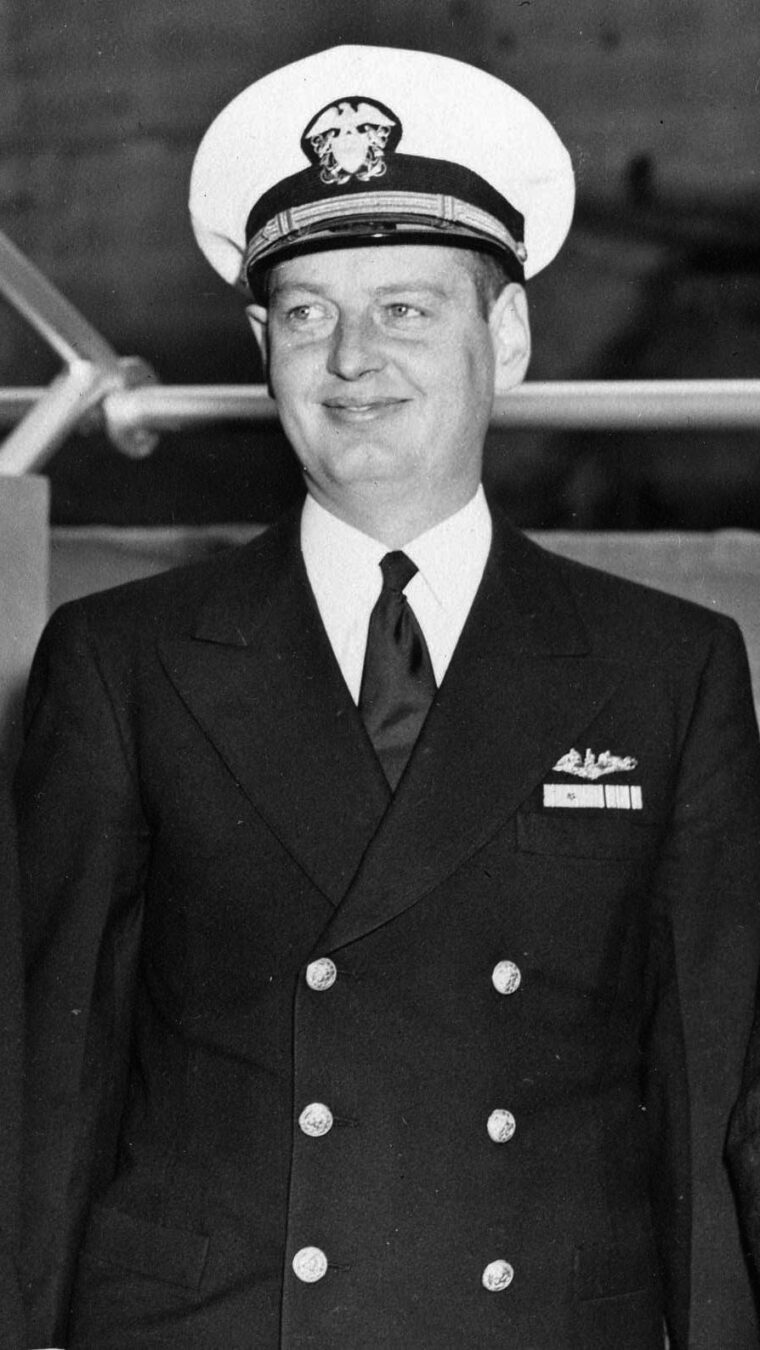
A Vulnerable Design
Conferring with his executive officer, Lt. Cmdr. Bob Bobczynski, he outlined his initial attack plan: “First, we’ll pull off the track, to the west. That will place the target down moon from us, and those dark clouds over the land to the northwest will tend to hide our dark hull from their lookouts.” After closing to five miles he would allow the leading escort to pass by, then he would charge in and attack. Enright passed on this plan to his officer of the deck, who bellowed through the hatch, “All hands to battle stations! Torpedo!”
Just before 10 pm, a lookout on the Japanese carrier’s deck screamed, “Periscope! Starboard bow!” However, when the ensign in charge of the watchers could see nothing through his binoculars he told the man he had seen nothing but “two waves colliding.”
Abe’s executive officer, Captain Mikami, was having misgivings about the ship’s watertight compartments. Like every man on board, he knew they were traversing waters teeming with American submarines. Because of the rush to get the Shinano carrier into action, the high command had cancelled the standard air pressure tests that would ordinarily ensure the compartments were indeed watertight. As the officer in charge of the untested watertight doors, he was worried they might not stand up to a sudden, drastic flow of seawater from a torpedo wound. He also fretted over the unusual construction of the passageways running the length of the vessel. Rather than the usual single main passageway, Shinano had been built with two major internal thoroughfares. There had been no time to drill the crew on escape procedures in case of an emergency. If the ship were to founder, a hefty percentage of the crew would doubtless become lost and trapped below decks.
Furthermore, only eight of the carrier’s 12 boilers were operational, and only six of these were being used. Once again the rush to get her seaborne had circumvented completion of needed tasks. With just eight boilers she could make only 21 knots, insufficient speed with which to launch planes unless there was a strong headwind. Her hurried completion had resulted in numerous ongoing malfunctions of various systems, yet there was nothing Abe and Mikami could do after receiving their orders. It was unthinkable for an officer of the Imperial Japanese Navy to defy the will of the high command.
Breaking Formation
Abe’s destroyer escorts had just participated in the Battle of Leyte Gulf. During this enormous engagement Hamakaze and Isokaze had both had their radar and sonar knocked out. All three destroyers had varying degrees of battle damage, and their crews were exhausted, but there had been no time for rest or repairs.
The commander would continue southward until some distance from the Japanese coastline, then veer southeast as if bound for Formosa. She would eventually turn due west and make for Kure to pick up the rest of her aircraft. Strangely, despite the spectacular success of the U.S. Navy’s submarine arm over the past two years, Abe was contemptuous of the quality of American torpedoes. Basing his opinion on his examination of older torpedoes captured during the conquest of the Philippines, it apparently never occurred to him that the Americans might have upgraded their torpedoes.
Before embarking, Abe had menacingly ordered his destroyer commanders not to stray from their positions close to the carrier. “If I believe an escort has left her assigned position I will call for her immediate return. The signal will be made by Shinano’s red truck light, which will be turned on and off for about 10 seconds. I strongly suggest that you do not make this signal necessary.”
At 10:45 pm, a phone call from the lookout bridge sent the ship’s senior officers scurrying for their binoculars. The lookout supervisor had told Mikami there was an unidentified object about nine miles off the starboard bow. “Quickly, up to the lookout bridge!” barked Abe.
As the officers strained to see the mystery vessel’s outline in the blackness, a lookout shouted, “Captain Abe, Isokaze! She’s left formation! She’s running at full speed for the unidentified ship!” The lead destroyer had sheered from her screening position dead ahead of the carrier and was charging at her full speed of 35 knots toward the intruder.
Chasing Shinano
The men on Archer-Fish’s conning tower had just realized their quarry was a big aircraft carrier rather than a tanker when a lookout told Enright, “Skipper, the lead destroyer, I think she’s coming our way!” As the Americans frantically scrambled to secure general quarters, Enright was mystified by the sight of the carrier suddenly flashing a bright red light atop her main mast. At first he thought it was a signal for the destroyer to open fire, but a lieutenant cried, “She’s turning, skipper! She’s turning away!” The submariners were further baffled to see the destroyer (which by then was only three miles distant) head back toward the carrier, aborting what might well have been a successful attack. Saved by Abe’s caution, the Americans resumed shadowing their target.
With Shinano steaming at 20 knots and Archer-Fish straining mightily to maintain her top surface speed of slightly over 19 knots, the carrier would have steadily outdistanced her pursuer had she not been slowed by her antisubmarine zigzag course. Thinking back on how he had ignored his instincts and as a result lost a chance at sinking Shokaku, Enright tossed the book aside and concentrated on what route he suspected the carrier would take. He and Bobczynski put their heads together and agreed that the carrier’s present 210-degree southwesterly heading was her base course. She was certain to veer off to her port in a continuation of her weaving antisubmarine procedure, but eventually would likely swing back to the right onto her apparent base heading.
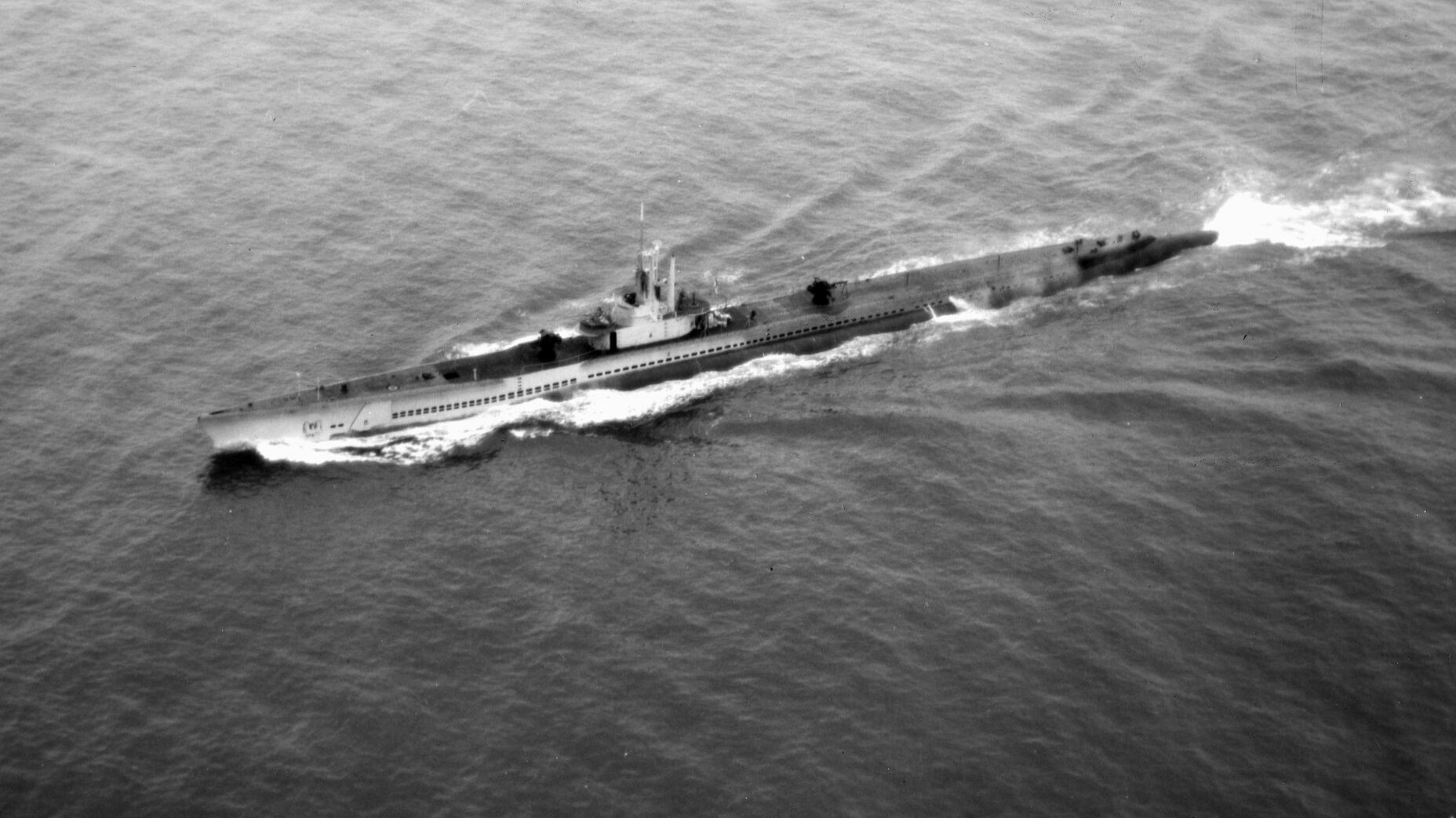
If Archer-Fish continued on the 210-degree southwesterly course after the carrier turned away she would be able to pull ahead of Shinano, whose crew, as the distance subsequently widened between the two vessels, would lose sight of the sub and presumably think they had outrun her. If the Japanese later did as anticipated and swerved back onto 210 southwest, they would then be headed back toward the submarine.
With so many American subs plying the oceans around Japan, the airwaves were filled with their radio transmissions and radar beams. With such a volume of wireless signals coming in from so many directions, Abe had given up trying to react to them. Furthermore, his hastily constructed ship was not fitted with the equipment needed to ascertain the distance or bearing of intercepted broadcasts. This meant Enright could use his radar to keep track of the carrier without scaring her off. For this same reason he could also safely use his radio, so he sent off a coded message to Lockwood back at Pearl Harbor to inform him of Archer-Fish’s present location and activities and those of her intended target in case another sub was in a better position to intercept Shinano. Despite his burning desire to bag the gigantic carrier, Enright refused to be greedy or selfish.
Resuming Course
Abe was still convinced he was being targeted by a group of subs and that the one they had sighted was trying to lure the escorts away from their priceless charge. He was accordingly enraged at Isokaze’s Captain Shintani both for disobeying direct orders and for falling for the ruse. Abe made a mental note to later severely reprimand or court martial his subordinate.
The captain was also certain that a lone submarine armed with inferior American torpedoes would never be able to fatally wound the Shinano. Yet, he feared a pack of submarines might be able to do it. He also suspected the raiders were tracking him on radar but that this would not matter because his superior speed would allow him to pull away from them.
At 11:22 pm, the machinery division’s chief, Lt. Cmdr. Miura, noticed that one of the main shaft bearings was overheating. Operating on just six of her dozen boilers, the carrier’s best speed was barely faster than a surfaced submarine. The malfunctioning shaft bearing slowed the warship to just 18 knots. Her slight speed advantage had vanished.
As Abe pondered this development, he also realized, now that he had turned away from the sub they had spotted and had lost sight of it, that there were two possibilities. Either he had outdistanced the craft before being forced to cut his speed, or the enemy commander had deliberately continued on the 210-degree course to the southwest in hopes of getting ahead of the Shinano in anticipation of her veering back toward the sub. Abe hoped the boat they had seen was alone and hence of no great consequence to the carrier. In any case, he had no choice but to return to his original heading if he was to reach his destination.
Enright was still puzzled by the strange actions of the destroyer. Could sheering off from its attack run mean it had been an American ship? Could the nearby U.S. Third Fleet have scheduled a surprise landing on or bombardment of the Japanese mainland? Surely if this had been the case the commanders of the numerous American submarines in the area would have been informed.
It was just before midnight as Enright pored over these factors. He was jolted from his musings when his radar operator stuck his head through the top hatch and announced, “We’ve got lucky, skipper! Based on radar the target’s made a sharp change of course. Almost straight west. The range is 13,000 yards, bearing 060 true, and his angle on the bow is 40 port.”
“Parallel His Course. Flank Speed.”
Enright and his officers clustered around the plotting table as they calculated the carrier’s approach and planned their attack run. Patting the rosary beads in his pocket, Enright bounded back up the ladder to the bridge.
The Japanese warships were plainly visible in the bright moonlight. After making more quick calculations, Enright told Bobczynski, “We’ll remain on course 210 degrees until we reach a track nine miles south and parallel to his track, then change course to 270. For him to make a reasonably good distance along his base course he can’t remain on a zig 60 degrees off that track for long, so he may come toward us at any time.” At straight-up midnight Bobczynski ordered the helmsman, “Come right to course 270 degrees. Parallel his course. Flank speed.”
Unaware that a malfunctioning shaft bearing was slowing Shinano, the Americans assumed she could still outrun them. Enright kept having visions of Shokaku steaming over the horizon and escaping him the year before. He was terrified this carrier would do the same thing. Before long, though, he could see the target had slowed, and he allowed his hopes to rise. His plan of attack was dependent on the ship returning to her base course of 210 degrees. When she did, Archer-Fish would be in optimum position with the carrier headed directly at her.
If Enright approached the Japanese on the surface they would spot him, but if he submerged his boat she would lose speed and the carrier might outrun him. He had to continue his passive, shadowing approach and pray for the carrier to swing his way.
Enright was pondering how the moon was due to set at 4:30 am, and at that point he would lose the moonlight he needed for a torpedo attack. Soon after that, the sky would begin to brighten, bathing the sub in sunlight and giving away her position to the enemy. He was staring forlornly at his wristwatch. It was 2:56 am, November 29, 1944. When he peered through his binoculars for the hundredth time he saw his prayers answered. The carrier was turning toward him. She returned to her heading of 210 degrees southwest. His prey and her escorts were now churning directly at him. At 3:05, Archer-Fish submerged and prepared to attack.
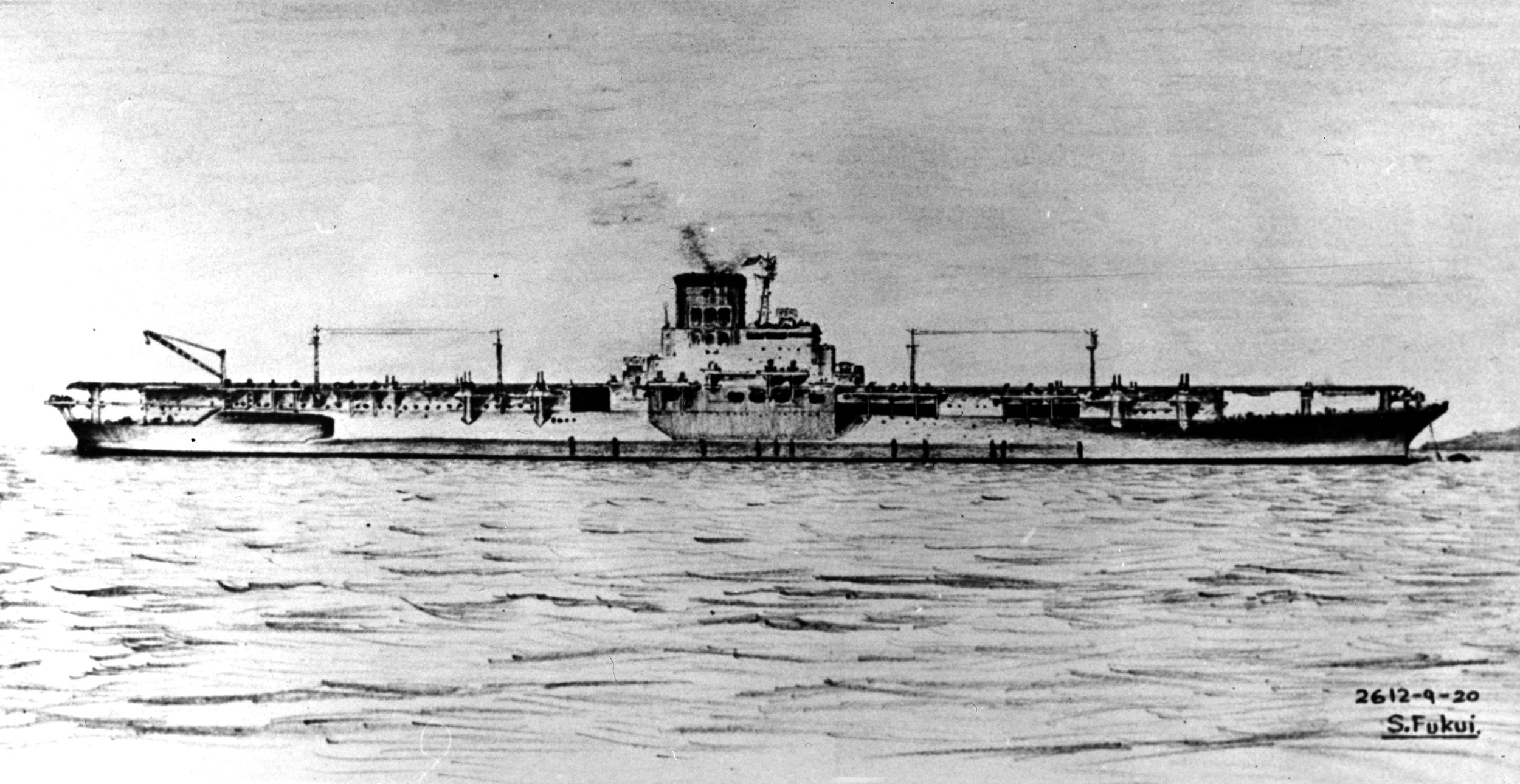
Striking Shinano
Leveling off at a depth of 60 feet, Enright yelled, “Flood the tubes! Set depth on the torpedoes at 10 feet!” Such a shallow depth setting befuddled some of the crewmen, but Enright was thinking back to a conversation he had a year earlier with Rear Admiral Freeland Daubin. The admiral had opined that torpedo hits on a carrier should come just under the water line because the great weight of the flight deck would destabilize the ship in the event of flooding high in her hull. This would make the vessel prone to capsizing and sinking more rapidly than flooding in the lower decks, which would result in her settling slowly in the water in an upright position. Enright was also aware that his Mark 14 torpedoes were known to run deeper than the depths for which they were set. He figured the 10-foot depth setting would cater to both considerations.
When the nervous Abe next ordered a 30-degree turn to port, he inadvertently turned his ship broadside to the submarine. Waiting for the carrier to pass in front of him, Enright had time to study her minutely through the attack periscope. Her outline did not match any in the recognition manual, so he drew a quick sketch of her. Ensign Gordon Crosby squinted at the drawing, noting the ship’s peculiar rounded bow designed to cut down wind resistance, and remarked, “The Japanese don’t have anything like that.”
“The hell they don’t. I’m looking at it,” Enright retorted.
At this point Archer-Fish had to drop beneath periscope depth as a destroyer passed directly over her, so close its prop wash shook the submarine. Luckily for the Americans, the destroyer was one of those whose sonar was inoperable from recent battle damage, and she blithely churned away from the sub.
The destroyer’s passing forced Enright to attack about a minute later than he had intended, but the carrier still filled the periscope’s field of view as he barked, “Fire one!” The firing plunger was pushed four times at eight-second intervals. The crew hastily reloaded the tubes, and two more torpedoes were fired.
His eyes glued to the periscope, Enright watched the first two balls of fire erupt against the vessel’s hull and was stunned at how quickly she listed. He resisted the temptation to keep watching and, delighted by the sound of additional strikes, ordered, “Take her down to 400 feet! Rig for depth charge attack.” Patting his rosary, he looked at his watch. It was 3:22 am, November 29, 1944.
All Hands on the Flight Deck
On Shinano’s bridge Captain Abe was reflecting on how the looming dawn would reveal his ship to B-29s when he was ripped from his thoughts of air attack by the first torpedo crashing against his stern. At eight-second intervals three more tore open gaping wounds along the length of his starboard hull. The first missile blew open an empty fuel storage reservoir and the ship’s refrigeration plant, which instantly flooded. The second wrecked the starboard outboard engine room, which also flooded. The third opened the no. 3 fireroom to the sea, killing every man on duty there and also inundating no. 1 and no. 7 firerooms. The last Mark 14 punched through the starboard air compressor room, causing instant flooding to it and to the no. 2 damage control station. This final shot also blew open the starboard ready fuel tank.
Abe had heard and felt torpedo explosions before and refused to lose his composure. Steadfast in his belief that American torpedoes were incapable of sinking his ship, he calmly announced, “Enemy torpedoes, gentlemen. Sound battle stations—all hands. Damage control status reports immediately. Casualties. Get to it!” Then, looking through the bridge’s frontal window, he was stunned to see the ocean tilted in front of him. Shinano was listing already.
Mikami rushed below to see for himself how sorely the vessel was hurt. Wind was whistling through the ship’s corridors as tons of incoming seawater forced air from the lower decks. He had a hard time keeping his balance as the list increased to 13 degrees despite the best efforts of the pump crews. After determining that the pumpers were doing their best, he headed, now knee deep in oil-coated seawater, to the no. 1 damage control station where he received a phone call from Abe. “We’re going to try to make Shiono Point,” said the skipper. “Do everything possible to right the ship.”
The crew’s efforts to save their ship were hampered by crowds of panicked civilian barbers and laundrymen as well as conscripted Korean laborers who could not understand orders shouted in Japanese. They had good reason for their terror. Miura later recalled, “The torpedoes pierced the hull like fists through a shoji screen.”
Water pressure was compounding the damage caused by the explosions as the inrushing ocean smashed through one compartment after another. With Shinano still maintaining her 18-knot speed, her velocity made the water pressure far greater than it would have been had she been motionless. Moments after Abe’s phone call to Mikami, the ship’s pumps failed.
The skipper announced over the loudspeaker that sooin (all hands) were to assemble on the flight deck. In the chaos, however, he misspoke. He had meant to say kooin (all civilians.) He wanted to get the milling nonmilitary personnel out of the way below deck as his crew sought to salvage the vessel. Instead, many sailors and officers who soon would have been trapped below began to make their way topside. Abe’s slip of the tongue saved hundreds of lives.
Mikami returned to the bridge and gave his dismal report to the commander. “Bad as it can be, captain. Four hits, and three of them struck in the citadel.” The citadel was the ship’s heart. It was a large section containing her boilers, engines, steering equipment, electronic and communication gear, and ammunition magazines. The torpedoes could hardly have been better aimed. Amazingly, Abe still thought Shinano could survive. Calmly, he ordered a message transmitted to Yokosuka Naval Station: “Shinano TORPEDOED AT 0317 X POSITION 108 MILES BEARING 198 DEGREES FROM OMAE ZAKI LIGHT.”
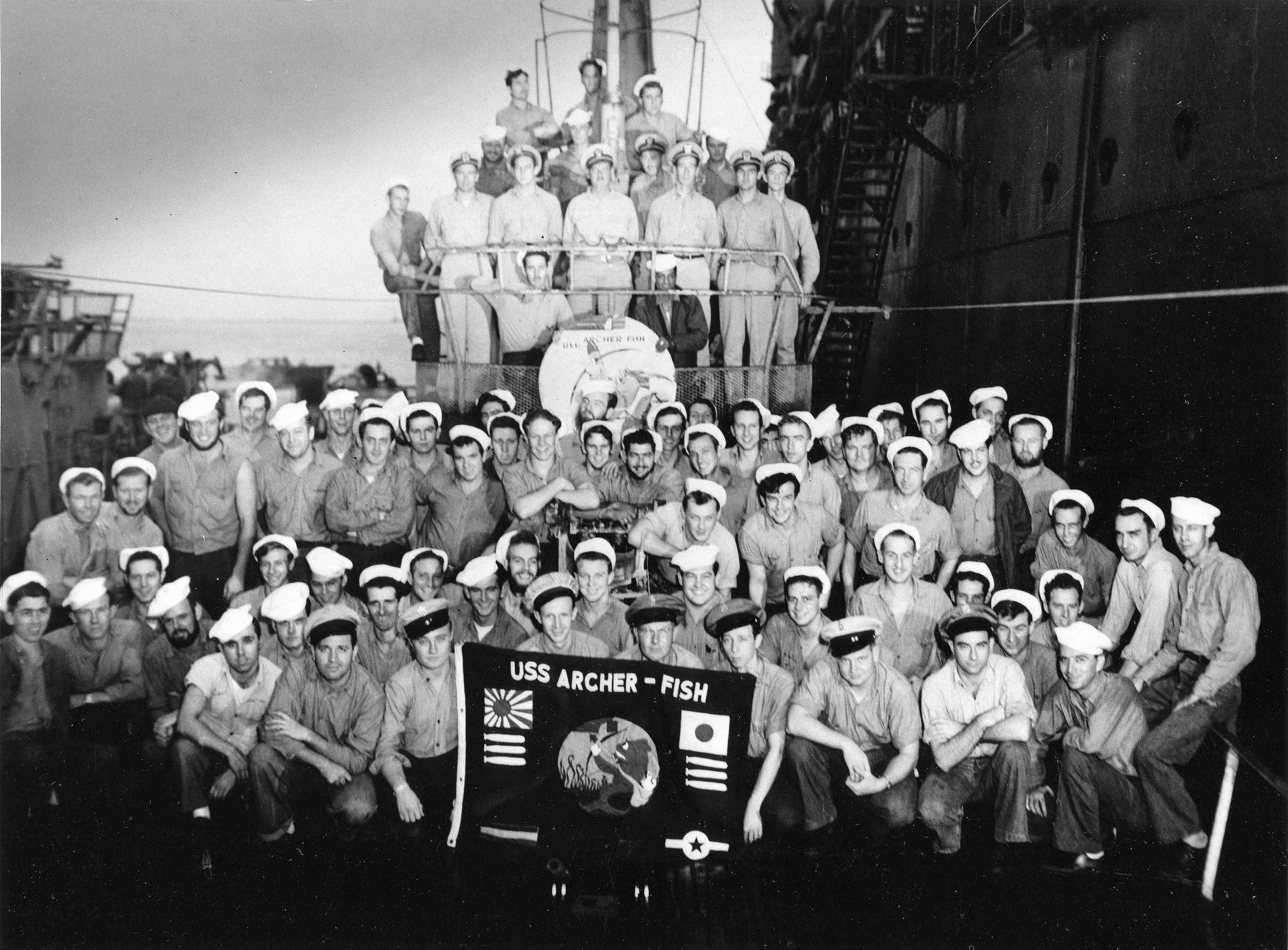
Down With the Ship
Two destroyers were now above the Americans, who could hear depth charges splashing into the sea. What the submariners did not know was that the warships attacking them had no operable sonar, but they soon figured it out as they counted 14 depth charge explosions over a 15-minute stretch. None came anywhere near Archer-Fish. “They don’t know where we are,” breathed a relieved Enright. “Damned if they don’t know where we are.” Virtually the entire crew whispered, “Praise the Lord.”
For 20 minutes the sailors listened to the fading sounds of depth charges and of the carrier breaking up. As realization of their success dawned on the crew, the sub reverberated with war whoops, rebel yells, and the patter of thousands of back slaps. Soon, however, the men grew silent as they began to contemplate the magnitude of their accomplishment. They were heroes, but only slowly did they gain total awareness of the hard-earned status.
At 6:10 am, Enright eased his vessel to periscope depth but, despite excellent visibility in the morning sunlight, could spot nothing in any direction. Exhausted, he headed for his bunk. At 10:55 a sailor woke him to say, “Cap’n, sonar heard—in fact we all heard—a deep rumbling explosion pretty far off. The officer on duty said to tell you he thinks it was our target going to the bottom.” The skipper smiled and went back to sleep.
An hour after the attack Abe finally allowed himself to realize the gravity of the situation. A vessel one-thirtieth the size of his had defeated him. The scorned American torpedoes had mortally wounded his carrier. Her list was now 20 degrees, and her speed down to 10 knots. At 6 am he ordered her course changed to the northwest in hopes of beaching the Shinano off Cape Ushio. Water poured through countless small internal leaks that there had been no time to find and fix in the shipyard, and crewmen desperately resorted to forming bucket brigades. The water kept rising.
At 8 am, Abe ordered the flooding of the outboard port boiler rooms in a frantic bid to reduce the list by counterflooding. Briefly the carrier did right herself, but soon the torrent pouring through the four gaping wounds in the starboard hull began pulling her aslant again.
By 9 am, she was dead in the water and her list was 20 degrees. Throughout the Shinano carrier’s vast interior men who had feared all along that their ship was hexed were struggling upward, hoping to make it to the deck before she capsized. Hamakaze and Isokaze made a pathetic effort to tow the carrier to shallow water, but with a combined weight of just 5,000 tons they could not budge the 72,000-ton vessel, which was made heavier still by the addition of thousands of tons of seawater.
At 10:18, Abe gave the general order to abandon ship. Aboard Yukikaze, Captain Terauchi ordered his executive officer, “Lieutenant, don’t pick up any sailors who cry or call for help. Such faint hearts can do the Navy no good. Pick up only the strong ones who remain calm and courageous.” Many more men drowned than were rescued. Abe was among 1,435 men who went down with their ship.
Honors for the USS Archer-Fish
Shinano is the biggest warship ever sunk by a submarine. She foundered 17 hours into her maiden voyage on Wednesday, November 29, 1944, 65 miles off the coast of the Japanese Home Island of Honshu.
Archer-Fish arrived at Guam on December 15. After her crew went ashore, Commander John Corbus, operations officer for the local Subordinate Command, shocked Enright by telling him, “I’m sorry, Joe, but Navy Intelligence won’t support your claim that you sank a carrier. They’re saying there wasn’t any carrier in Tokyo Bay, so how could you have sunk one? Will you settle for a cruiser?”
Enright and his men made it clear they were in no mood to settle for anything except the trophy they knew they had bagged. Enright still had the pencil sketches he had made of Shinano. He gave them to Corbus, who attached them to the patrol report he forwarded to Naval Intelligence in Pearl Harbor. When the intelligence officers saw the distinctive, bulbous clipper bow Enright had drawn, they realized his kill had been the suspected third super warship of the Yamato class and that the Japanese had converted her to an aircraft carrier, although the intelligence people seriously underestimated her weight at 28,000 tons. Further confirmation came from an intercepted Japanese radio transmission from November 29: “Shinano sunk.”
After the war, the United States Technical Mission to Japan interviewed surviving Japanese naval personnel and, based on information from these interrogations, upgraded the size of Archer-Fish’s trophy to 70,755 tons. For his triumph, Enright was awarded the Navy Cross, and his submarine received a Presidential Unit Citation.
In peacetime Archer-Fish served as an oceanographic research vessel and was decommissioned on May 1, 1968. Later that year the Navy used her as a target in the test firing of an experimental torpedo fired by the nuclear submarine Snook. The USS Archer-Fish was towed to a point several miles off the coast of San Diego and anchored. The new torpedo broke her in two.
Kelly Bell is a freelance writer from Tyler, Texas. He has done extensive research on submarine operations during World War II.
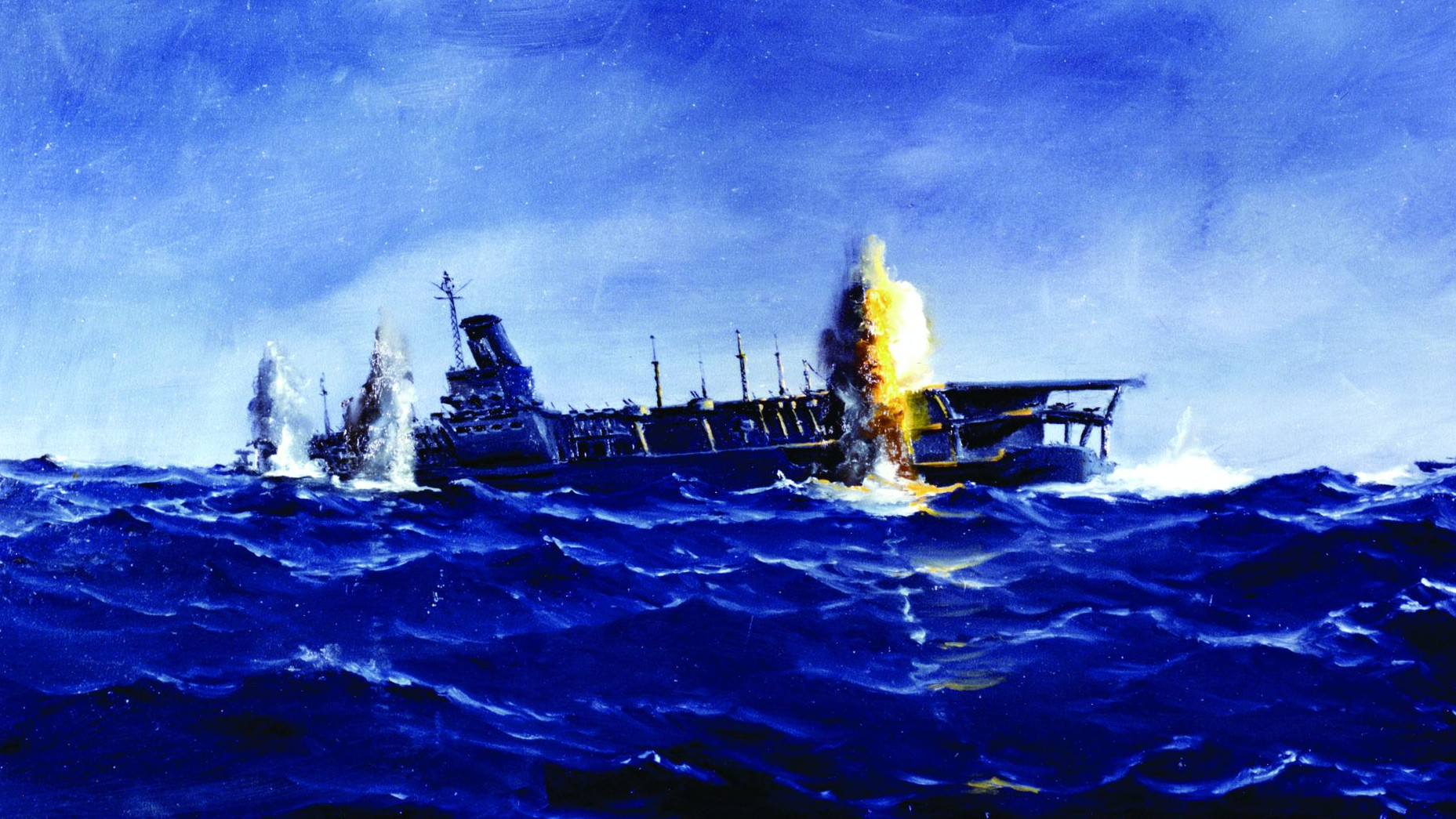
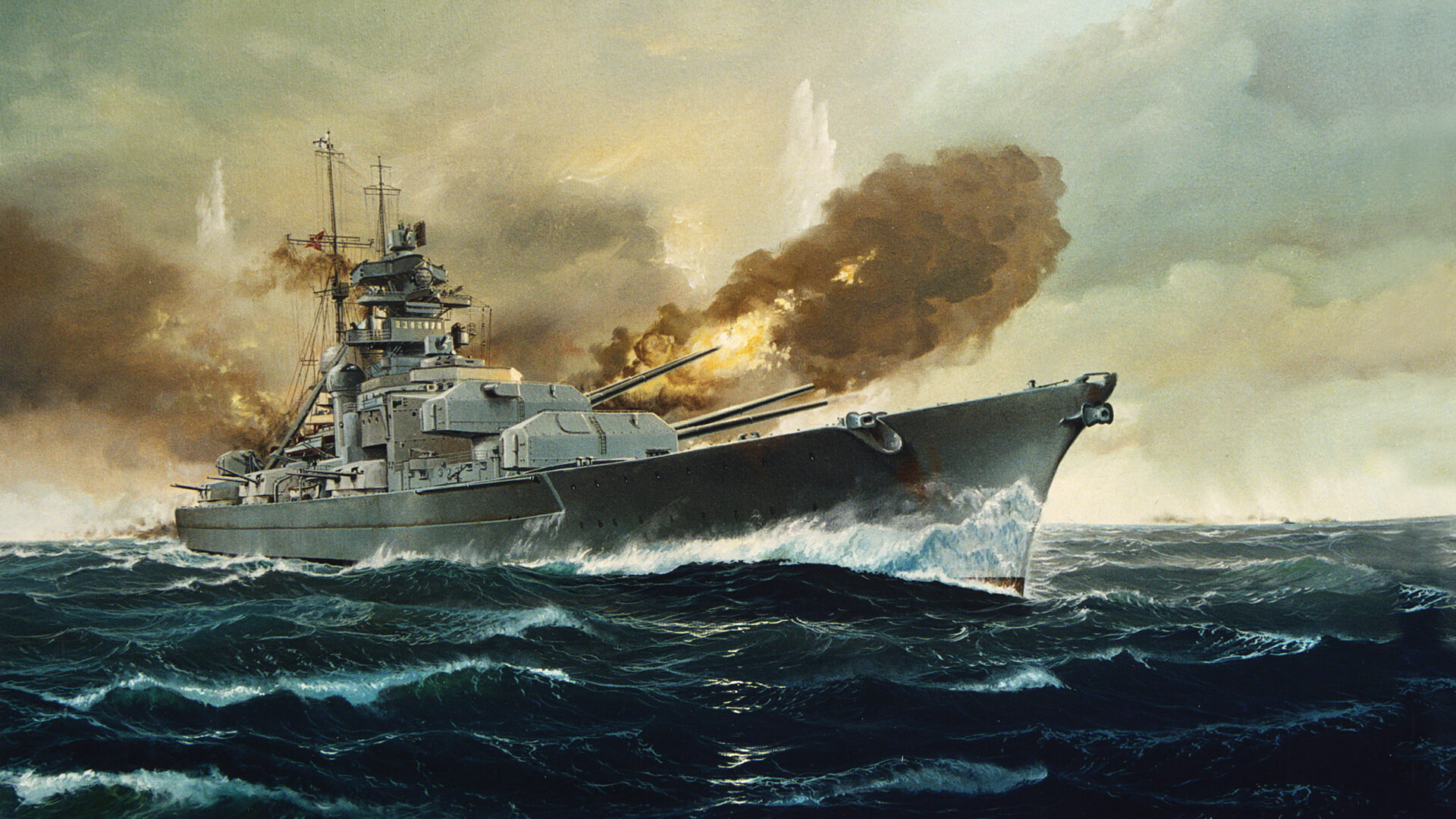
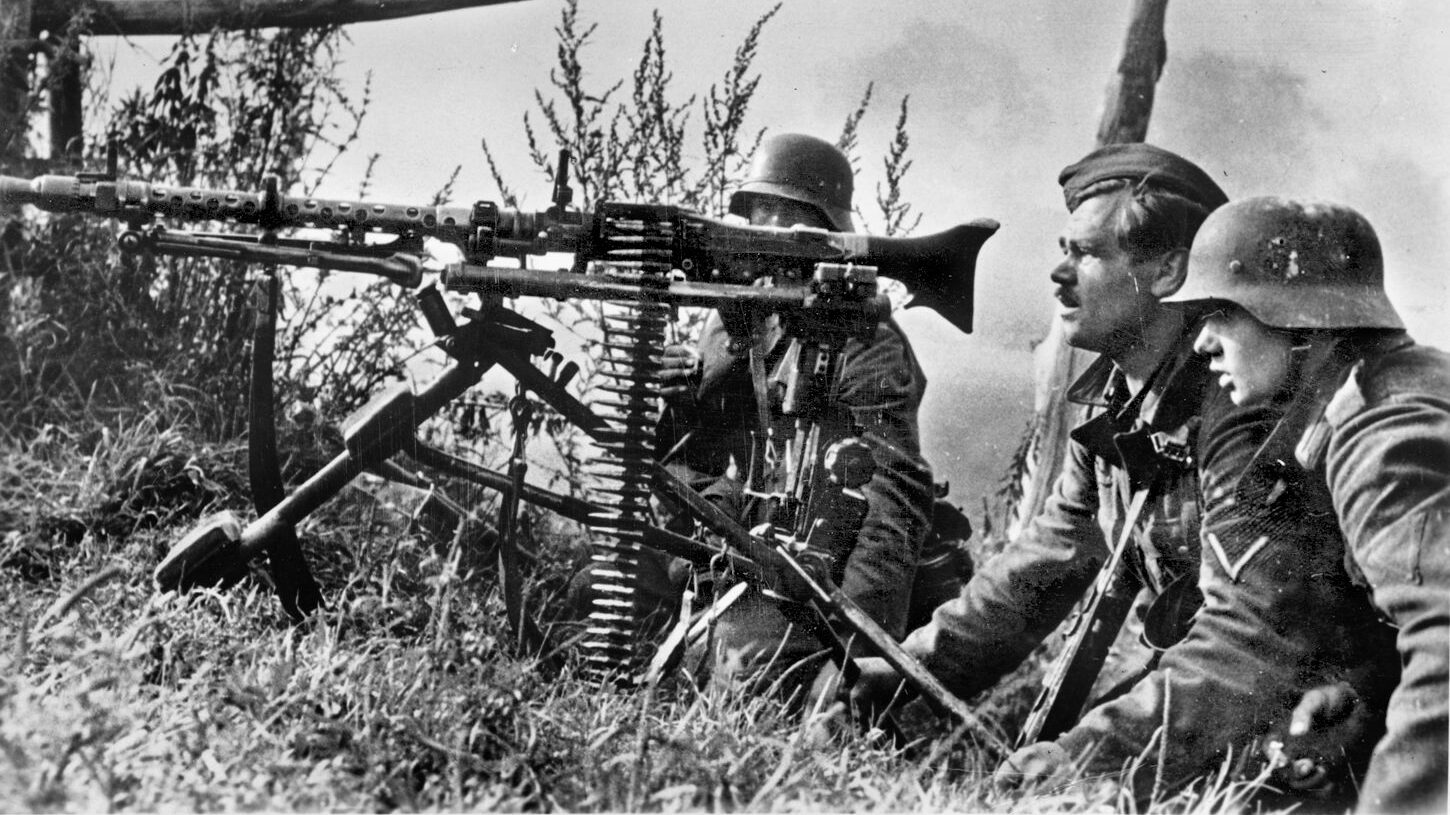
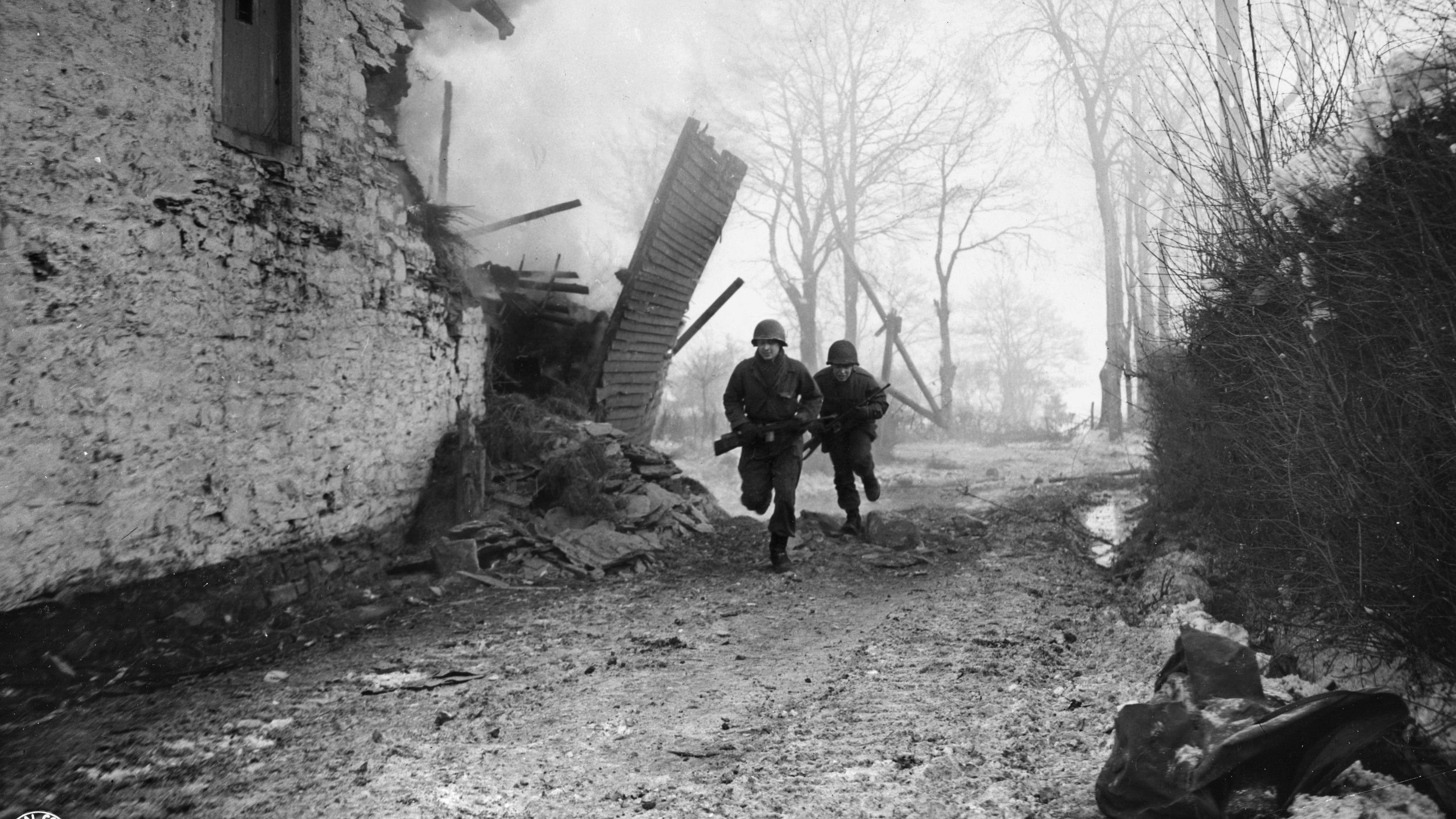
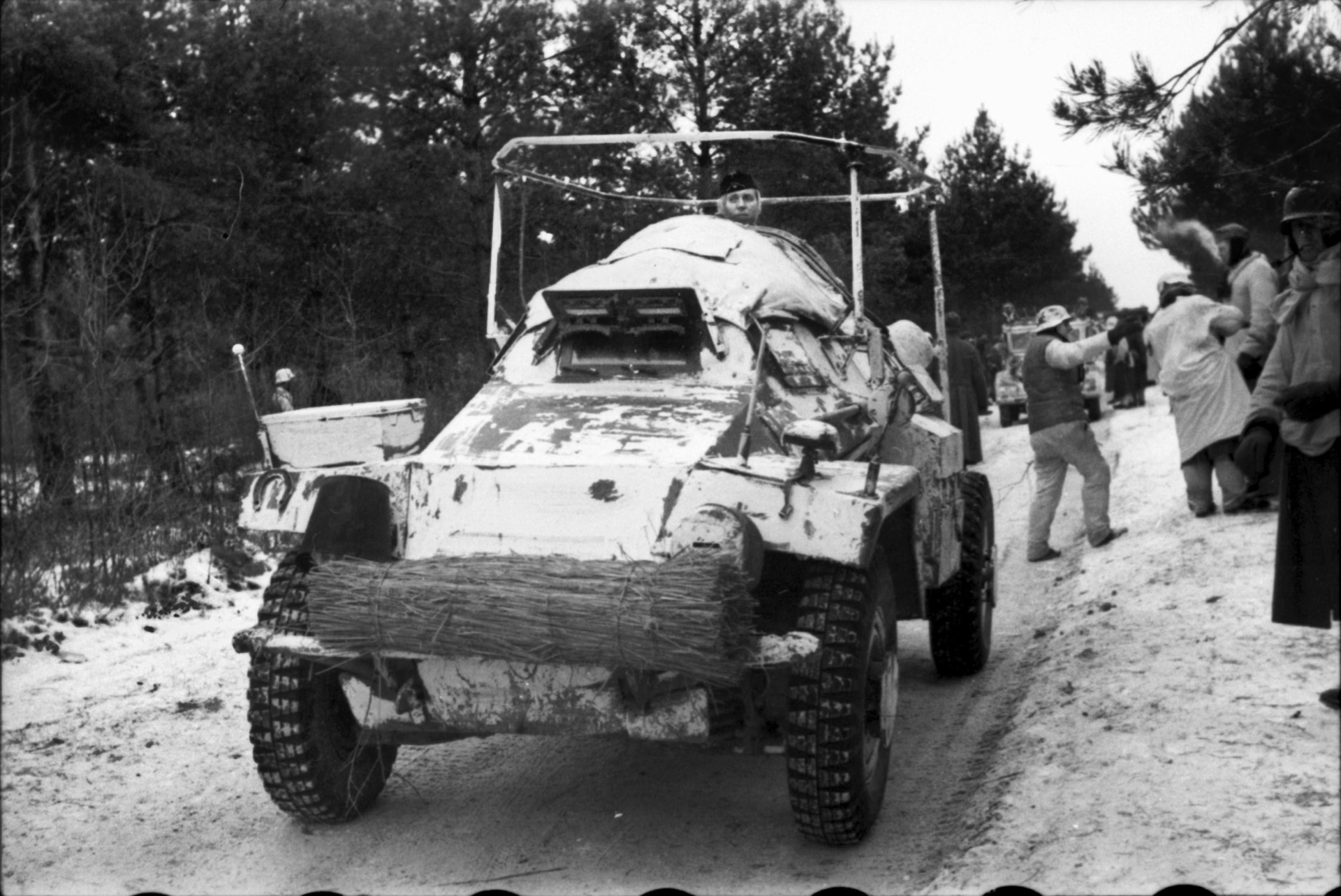
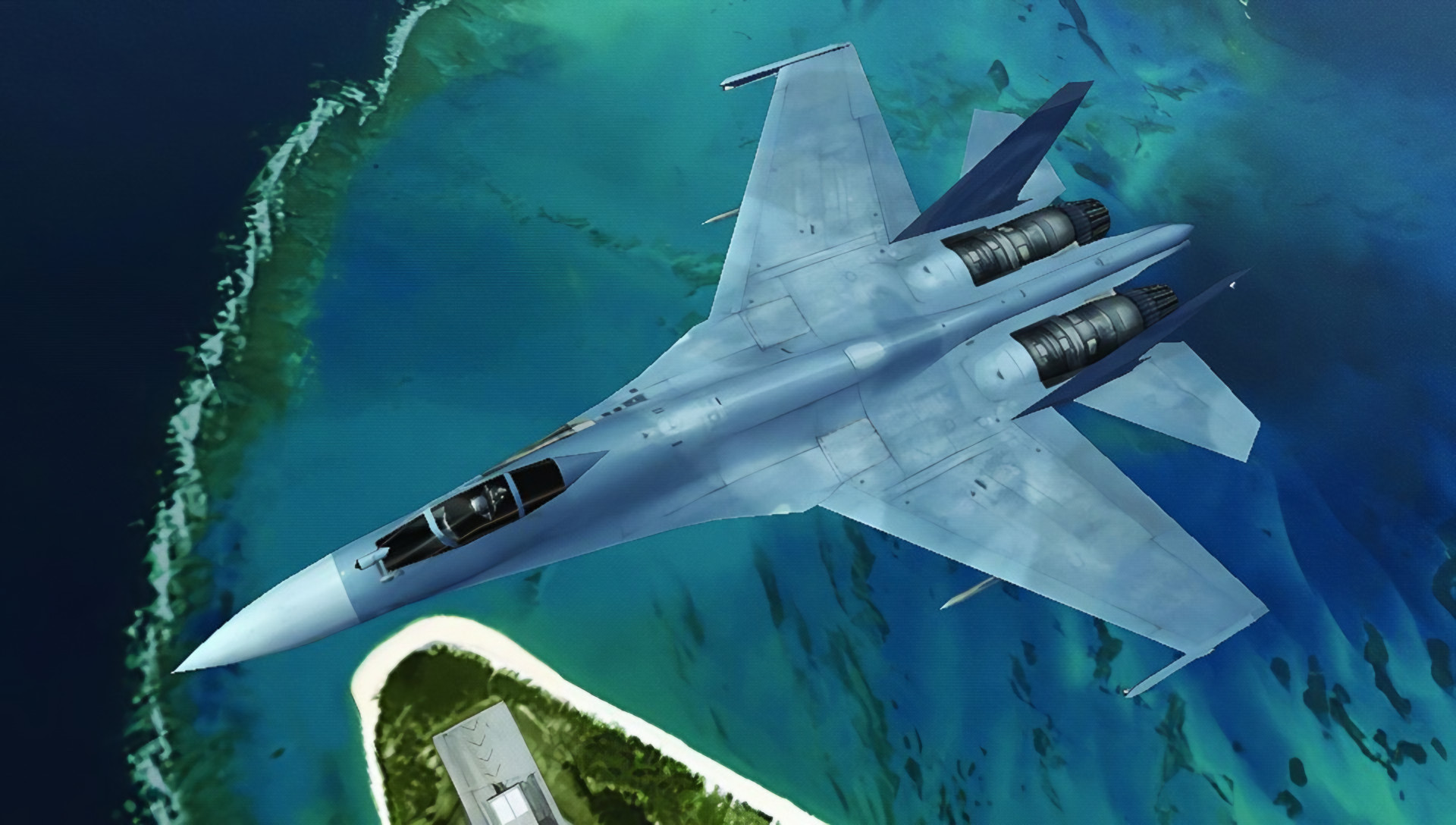
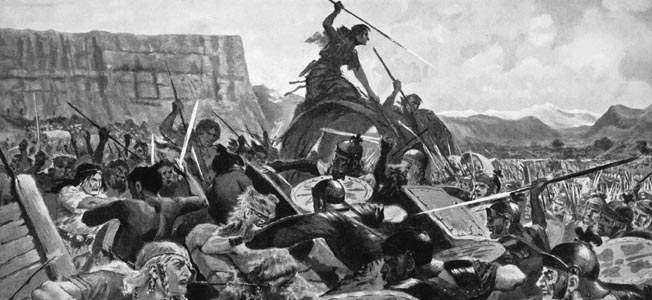
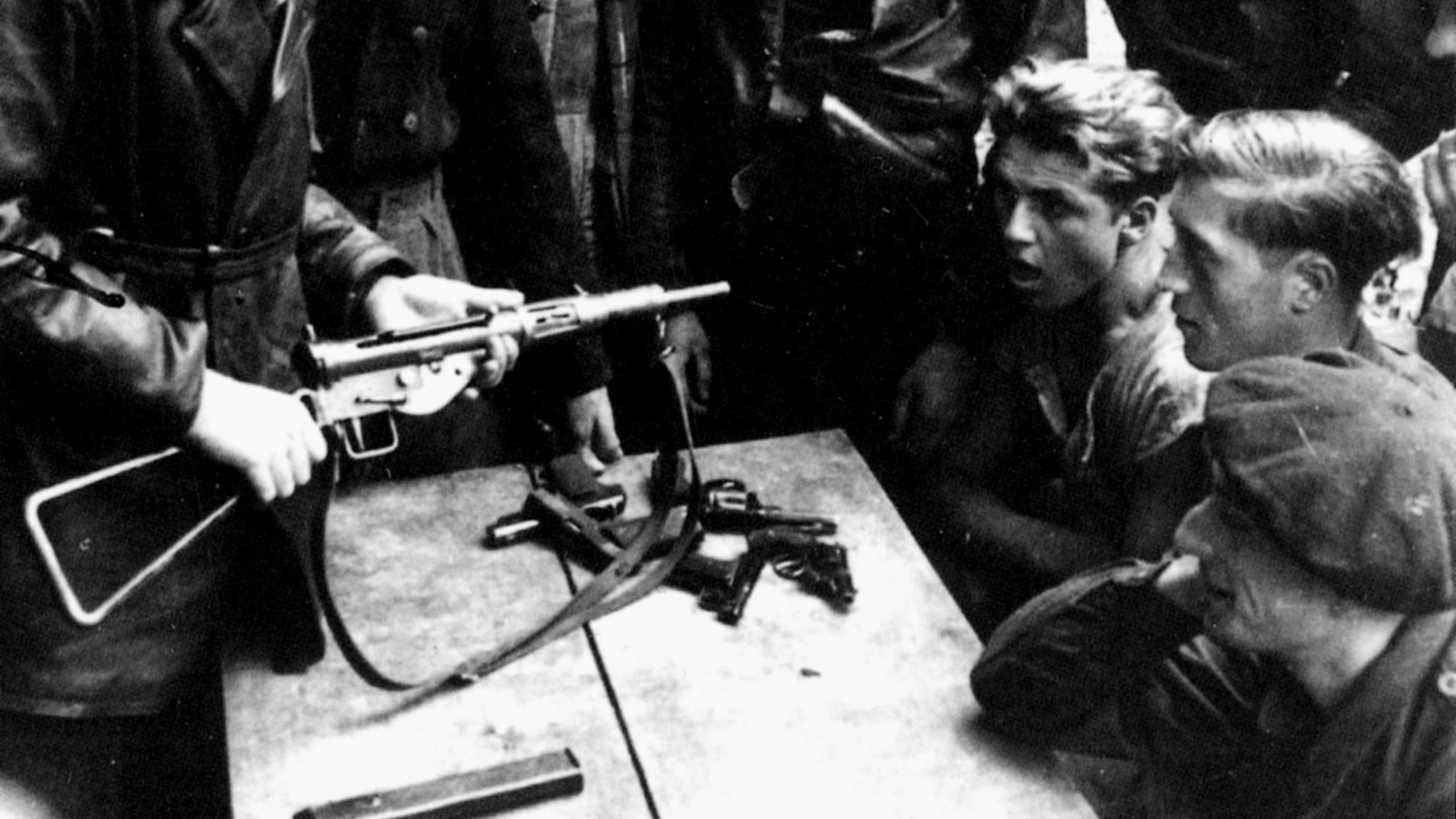
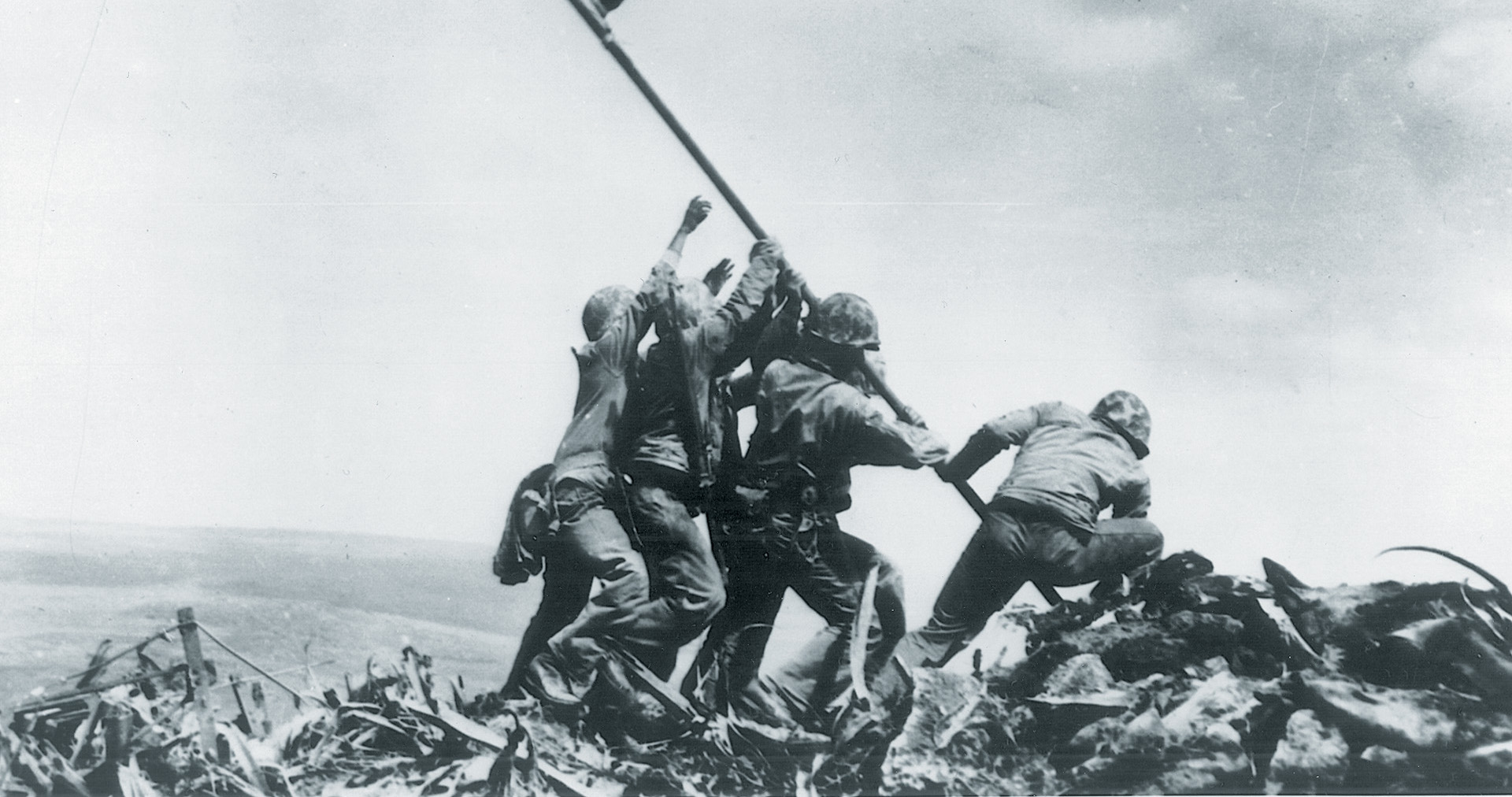
Join The Conversation
Comments
View All Comments